France have competed in the Women’s Olympic Football Tournament twice before, finishing in fourth place in 2012 before getting eliminated in the quarter-finals in the 2016 edition.
This year, with Les Bleues set to compete in front of their home fans, motivation will be at an all-time high among a squad of players with great ability to deliver Olympic success.
This tactical analysis piece will provide analysis in the form of a team-focused scout report detailing what tactics you can expect from international tournament specialist Hervé Renard’s side this summer.
Predicted Starting XI
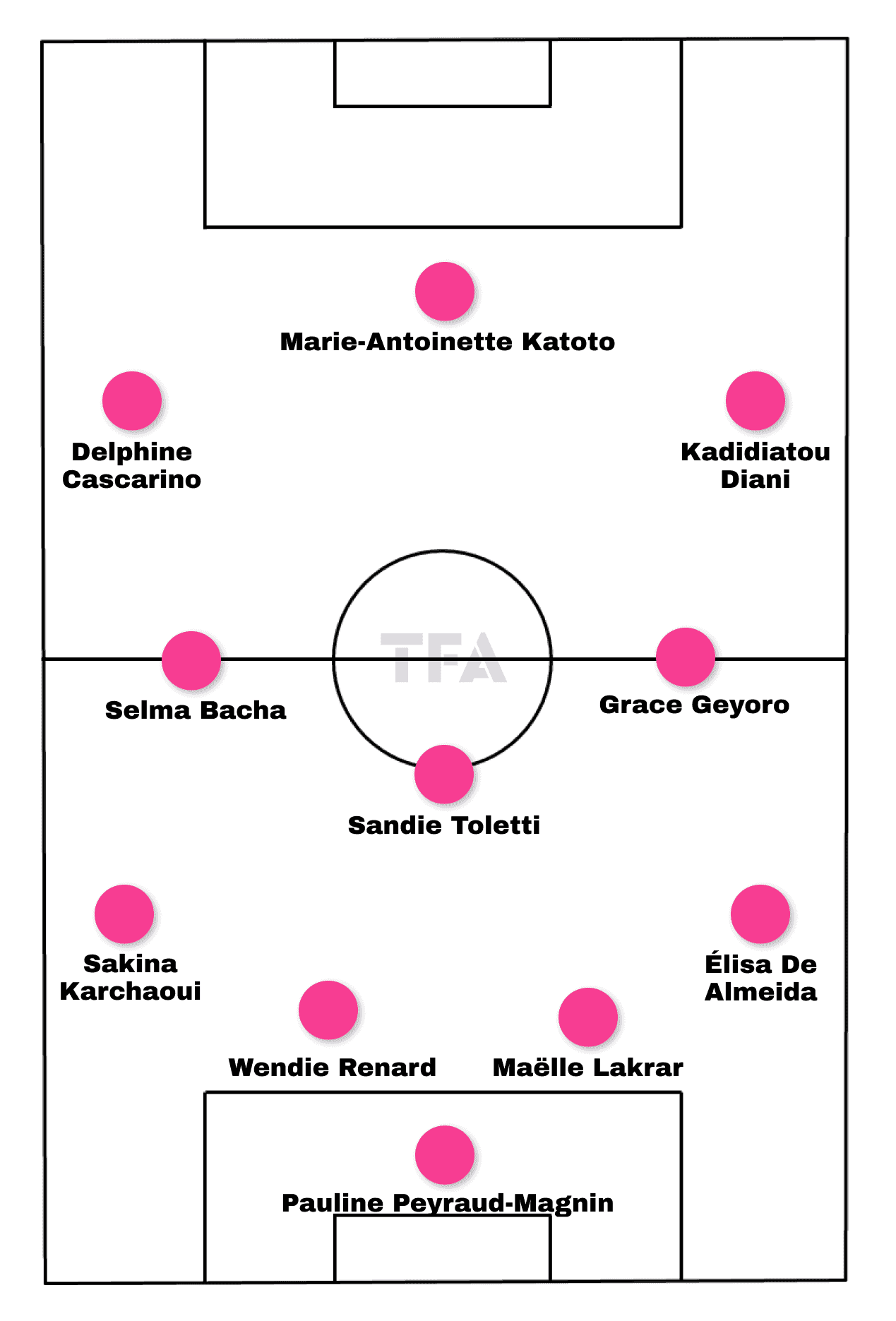
We’ve got Renard lining his side up in a 4-3-3 shape with one holding midfielder behind two more advanced central midfielders, as depicted in figure 1, though he’s also used the 4-2-3-1 at times with this France side.
Most frequently, we’ve found France defending in a 4-1-4-1 and attacking in something resembling a 4-3-3, the specifics of which we’ll go into greater detail on in later stages of this scout report.
Pauline Peyraud-Magnin is likely to start between the sticks, with the Juventus stopper having essentially made the position hers.
She’ll be protected by a back-four consisting of right-back Élisa De Almeida, right centre-back Maëlle Lakrar, left centre-back Wendie Renard and left-back Sakina Karchaoui.
Sandie Toletti is likely to start at the base of France’s midfield three behind our duo of Grace Geyoro at right central midfield and Selma Bacha — a versatile player capable of operating in central midfield, at left-back or at left-wing — occupying left central midfield as she often has for Renard.
In attack, we’ve gone for Delphine Cascarino on the left, the 2023/24 UEFA Women’s Champions League top scorer Kadidiatou Diani of Lyon on the right and the same prestigious competition’s second-highest goalscorer, Marie-Antoinette Katoto of PSG through the middle.
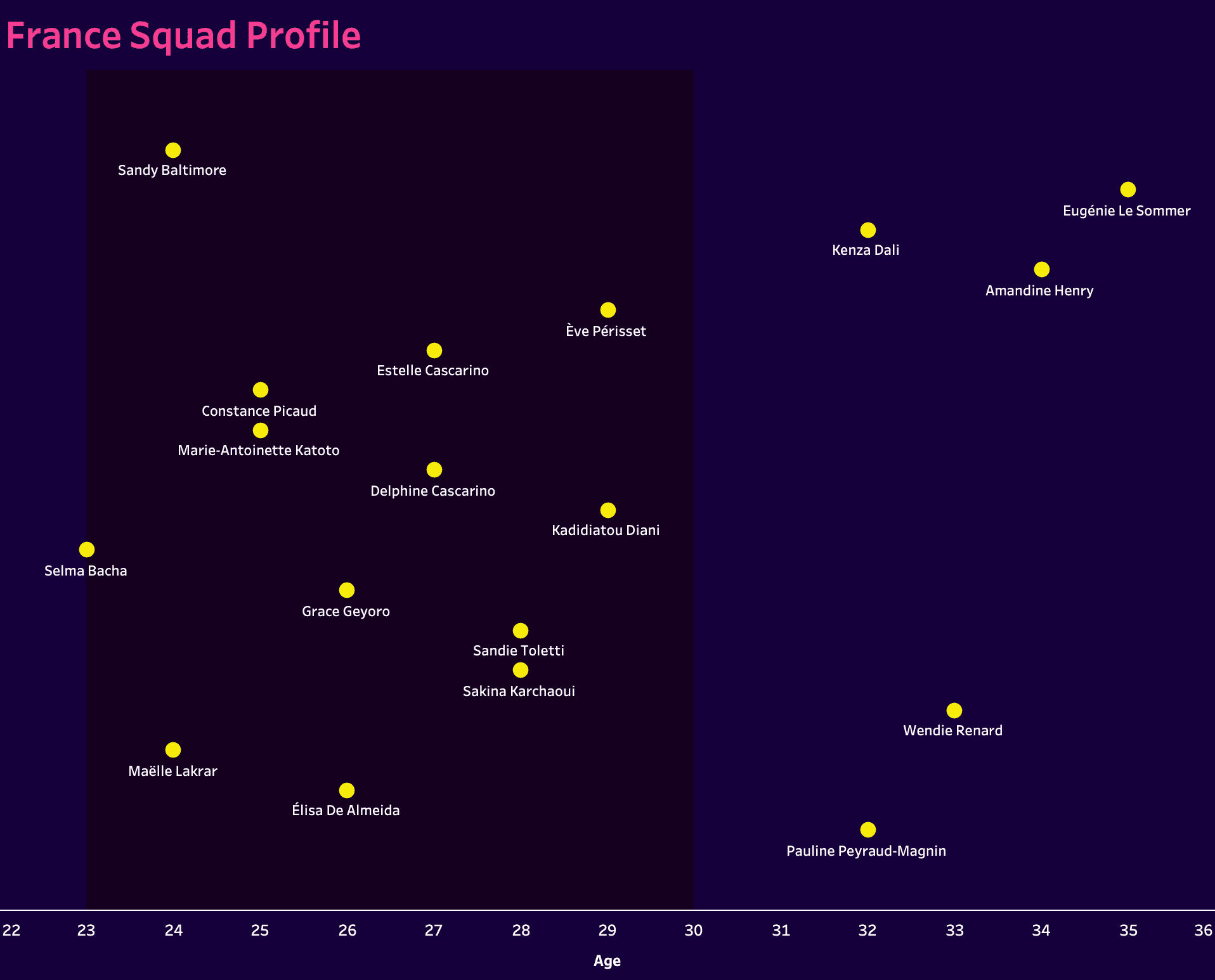
On the substitutes bench, with this piece being written before Renard’s official 18-player squad has been announced, we’ve included Constance Picaud as the backup goalkeeper, Estelle Cascarino and Ève Périsset as defenders, Amandine Henry and Kenza Dali as midfielders along with Eugénie Le Sommer and Sandy Baltimore as forwards.
That leaves us with a fairly experienced squad for the tournament featuring just one player aged 23 and under — Selma Bacha — with five over 30, including goalkeeper Peyraud-Magnin and captain Wendie Renard.
The majority of the team, including nine of the starting XI, are in their prime years, giving them as good a chance of achieving success on the international stage now as they’ll likely ever have. France’s squad is a strong one that should be underestimated by any opponent at their peril.
Attacking phase
Regardless of whether they line up in a 4-1-4-1 or 4-2-3-1 out-of-possession on paper, France tend to attack with a lone holding midfielder. Meanwhile, they will almost certainly play with a back-four with the centre-backs splitting a bit wide without the ball, allowing that holding midfielder to drop slightly and creating a central passing option for the goalkeeper between the left and right centre-back options.
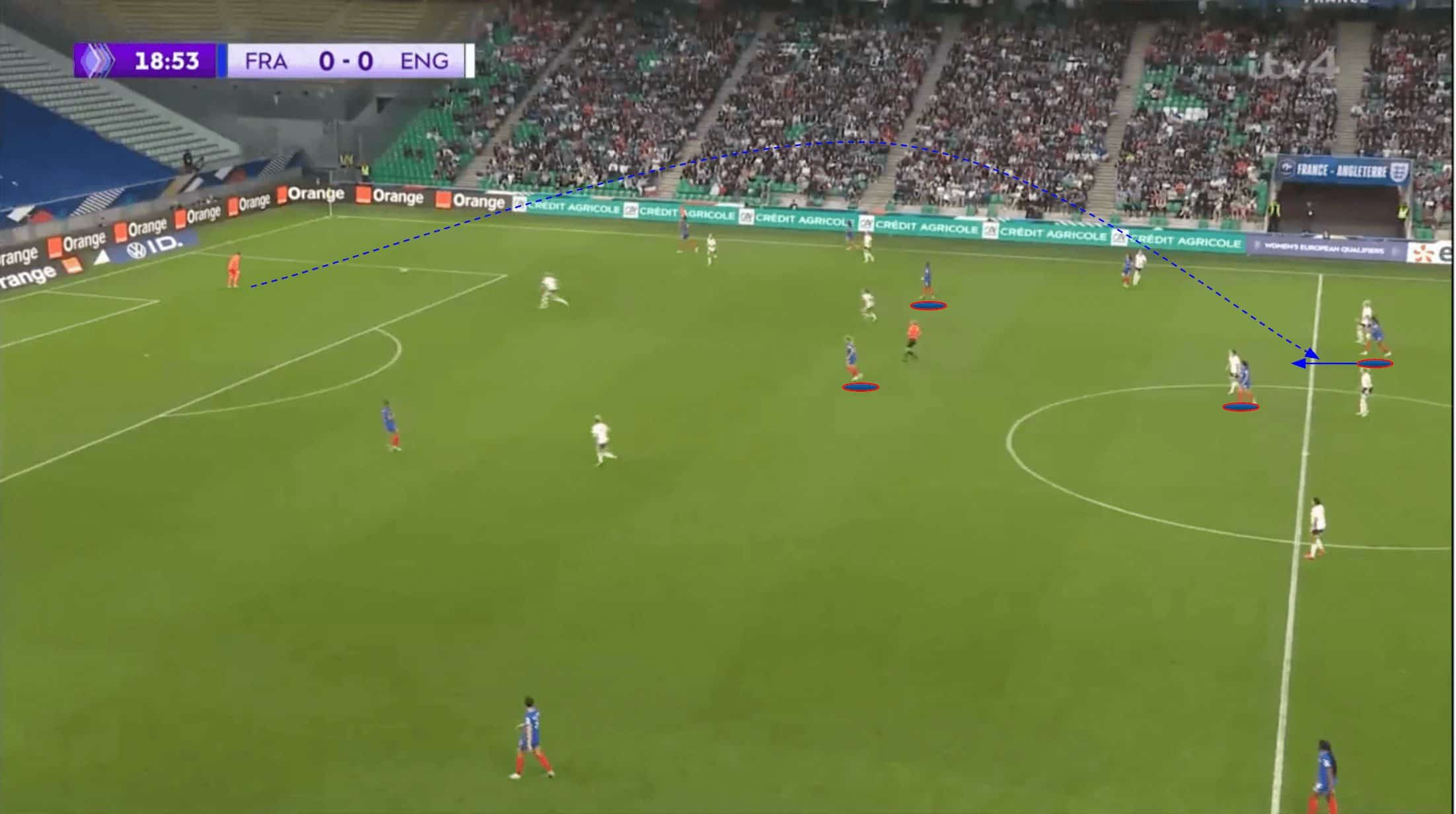
Figure 3 provides an example of France lining up in a 4-2-3-1 versus England. As the goalkeeper gets on the ball here, watch how the double-pivot drifts apart, with one dropping to become the holding midfielder while the other advances to join the ‘10’ just off the striker when we progress into figure 4.
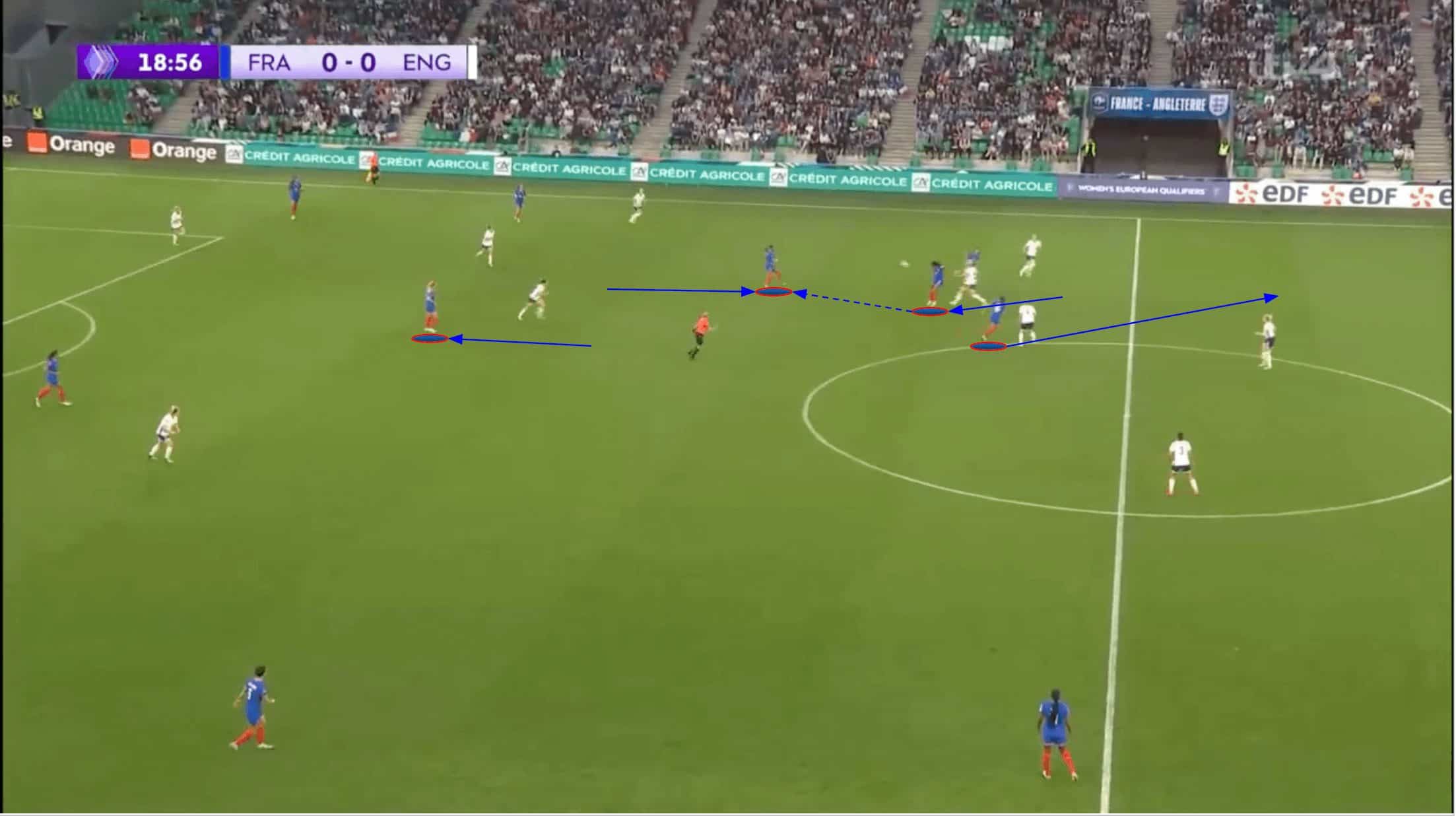
This long ball is played towards the centre-forward, who is then able to link up with the midfielder advancing from deep while the actual ‘10’ begins making a run in behind to attack the space vacated by the centre-forward. The striker has successfully forged a gap in the English backline by dragging the right centre-back into midfield via her off-the-ball movement.
This creates an excellent opportunity for the central midfielder to play the advancing ‘10’ through behind the English backline — a great example of how France can generate opportunities for penetration in possession.
Renard is a coach whose teams are typically very possession-based—that’s no different with this France side. Expect to see them approach games with the aim of controlling the ball for the majority of the contest.
At the same time, the likes of Wendie Renard and Élisa De Almeida are solid ball-playing defenders who, along with Peyraud-Magnin, will look to exploit the hold-up abilities of Katoto and get the ball forward early, at times, as we saw in figure 4, so opponents will also need to be prepared for this type of ball, along with the off-the-ball movement this type of pass will trigger from those around Katoto which could create opportunities for the intricate passing combinations Hervé Renard loves to see his team pull off when seeking opportunities for chance creation.
France generally like to play out through their centre-backs from the build-up, but captain Renard’s ball-playing ability exceeds that of Lakrar. The latter could be targeted with an intelligent pressing scheme, especially due to her tendency to carry the ball into wider areas on receiving. This leaves her open to being pressed hard from out-to-in, forcing her into a rushed action.
The wingers often start wide in earlier phases of the attack but will come narrower as the attack progresses, especially the left-winger with Sakina Karchaoui, who is likely to be bombing up and down the flank from left-back.
Defensive phase
This France team is comfortable defending high as a unit. They tend to press the opposition right from the beginning of their build-up, with the centre-forward likely to try and cut the pitch in half by positioning herself between the centre-back on the ball and the opposite centre-back, as we see in figure 5.
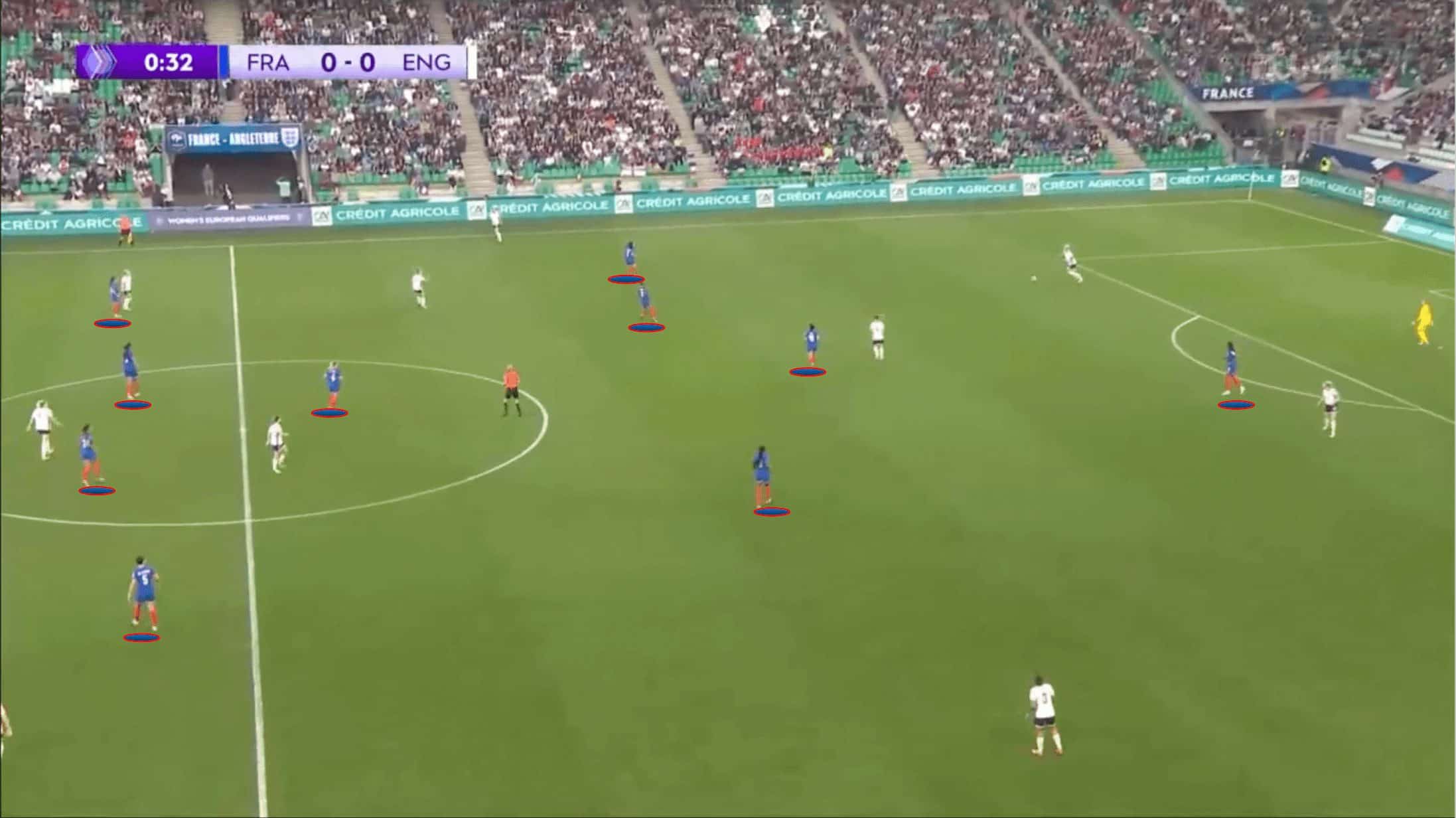
The 4-1-4-1 defensive shape we referenced earlier is also on show in figure 5, though we can see the right central midfielder getting dragged a bit high by the opposition’s holding midfielder.
In general, France defend in a position-oriented 4-1-4-1, but players will pick up opponents who enter their zone, with the midfielders, in particular, marking tight.

We often find one of France’s central midfielders — or the ‘10’ if they are playing with a 4-2-3-1 — joining the centre-forward in the first line of pressure when Les Bleues decide to really press the opposition’s backline, as shown in figure 6.
In addition to these tactics, which attempt to rule out the opposition’s numerical advantage versus France’s lone striker in the build-up, their other central midfielder will pick up the deepest midfielder, as we can also see above.
When France press high, we always find their wingers positioned quite narrow and this holds even more true when the central midfielders push closer to the centre-forward. The purpose of this is to ensure the centre of the pitch remains horizontally compact and difficult for the opponents to find space to play through the French.
However, a downside to these aggressive tactics is that France’s midfielders can get pulled too high, leading to an excess of space opening up between their midfield and defensive lines.
This can allow opponents with intelligent passers and smart off-the-ball movement to create opportunities for ball progression into dangerous areas—something France’s opponents should be aware of and aim to exploit in this summer’s tournament.

Figure 7 shows another instance of France’s centre-forward cutting the pitch in half and forcing the opponent to play to one side of the pitch. This leads to the full-back on that wing pushing up while the midfield shifts over to congest the space around the wide ball carrier and deny further progression.
Les Bleues are very good at pressing in this manner, denying central progression for the most part and using the sideline as an additional defensive weapon. However, this type of pressing comes with its drawbacks, one of which is evident in the passage of play above.
The opposition are able to switch the ball back over to the opposite side of the pitch via the goalkeeper, where France have now got no players readily available to press. Opponents who are able to effectively switch the ball from one side of the pitch to the other at pace have the capacity to hurt France as a result of their pressing tactics to congest space out on the wing, which could lead to goalscoring opportunities.
Transitions
Defensive transitions are another area in which Hervé Renard’s side could encounter issues and where Peyraud-Magnin could be called into action.
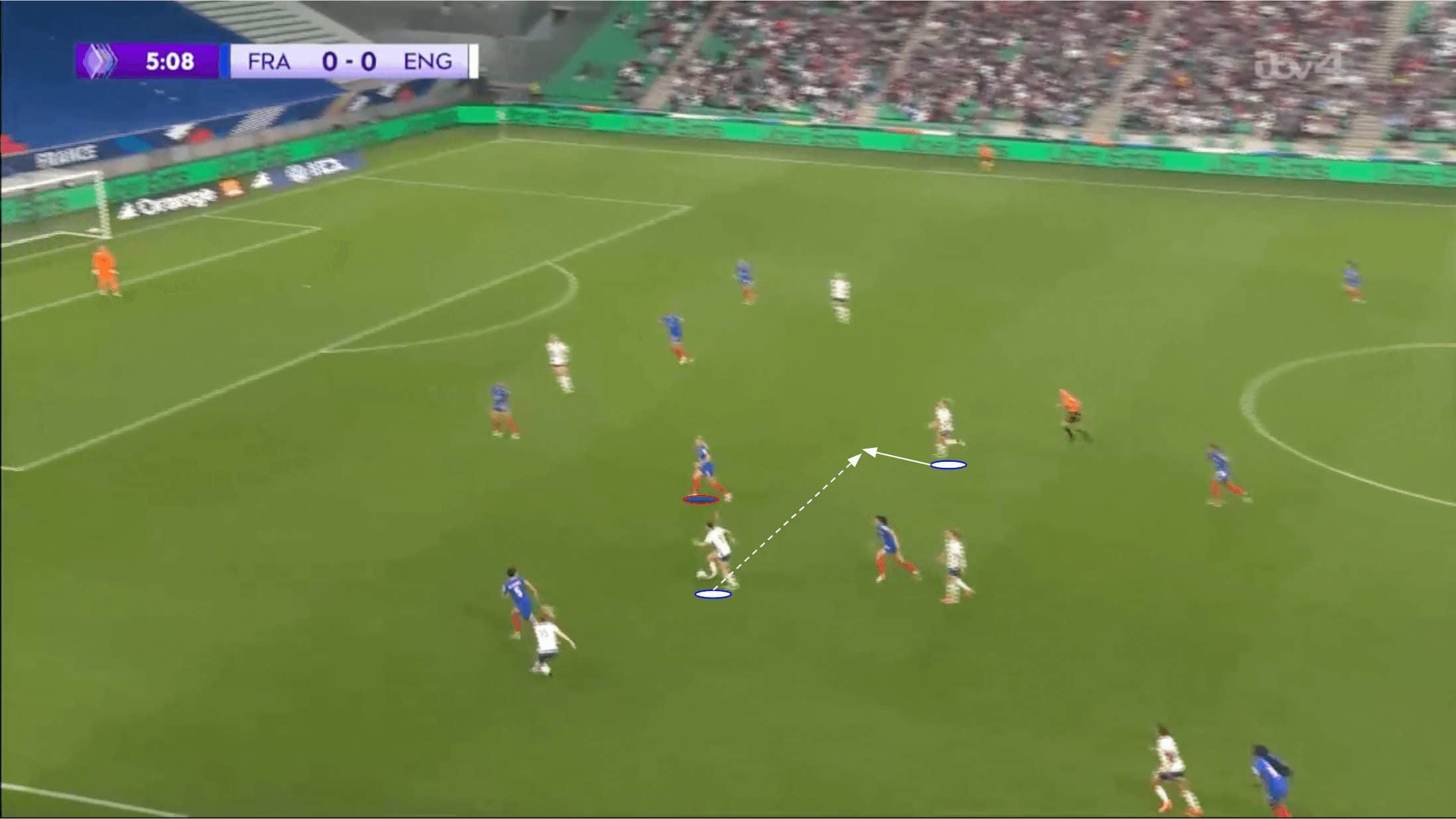
As mentioned earlier, France tend to build their attacks with one deep-lying midfielder in front of two centre-backs spread fairly wide. Should they lose possession in the middle of the park, where the opposition will be likely to press with some level of intensity, it could leave that holding midfielder vulnerable to an overload, as England proved in this example shown in figures 8 and 9.
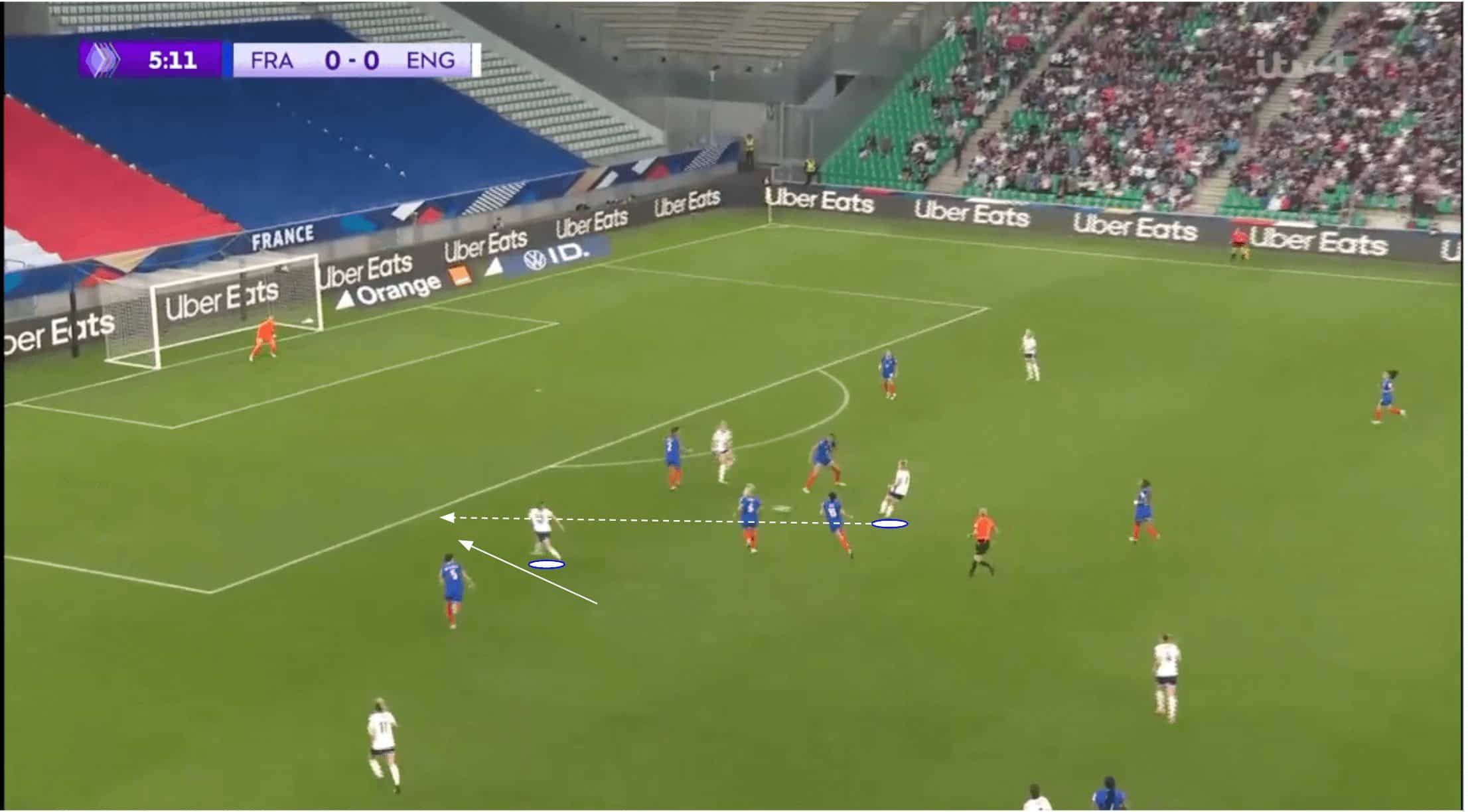
After winning the ball from France’s right central midfielder, they create an opportunity to counter and perform a nice one-two combination around the lone holding midfielder, leading them in behind the French backline and through on goal.
This directly resulted from a cheap loss of possession in the middle third. France’s opponents should aim to create similar opportunities in transition during the Olympics if they want to maximise their chances of troubling Les Bleues’ net.
When attacking further upfield, it’s common to see France keep three defenders in the backline — probably with right-back De Almeida shifting over alongside the central defensive duo. At the same time, Karchaoui moves forward on the left, and the left-winger moves inside.
Diani on the right will also come inside but will likely hold the width on that side of the pitch for slightly longer — expect her to make intelligent runs inside both on and off the ball, however, with her goalscoring prowess likely to prove vital to Hervé Renard’s offensive strategy.
In offensive transitions, France’s ball carriers will be key, including the wingers and two more advanced central midfielders.
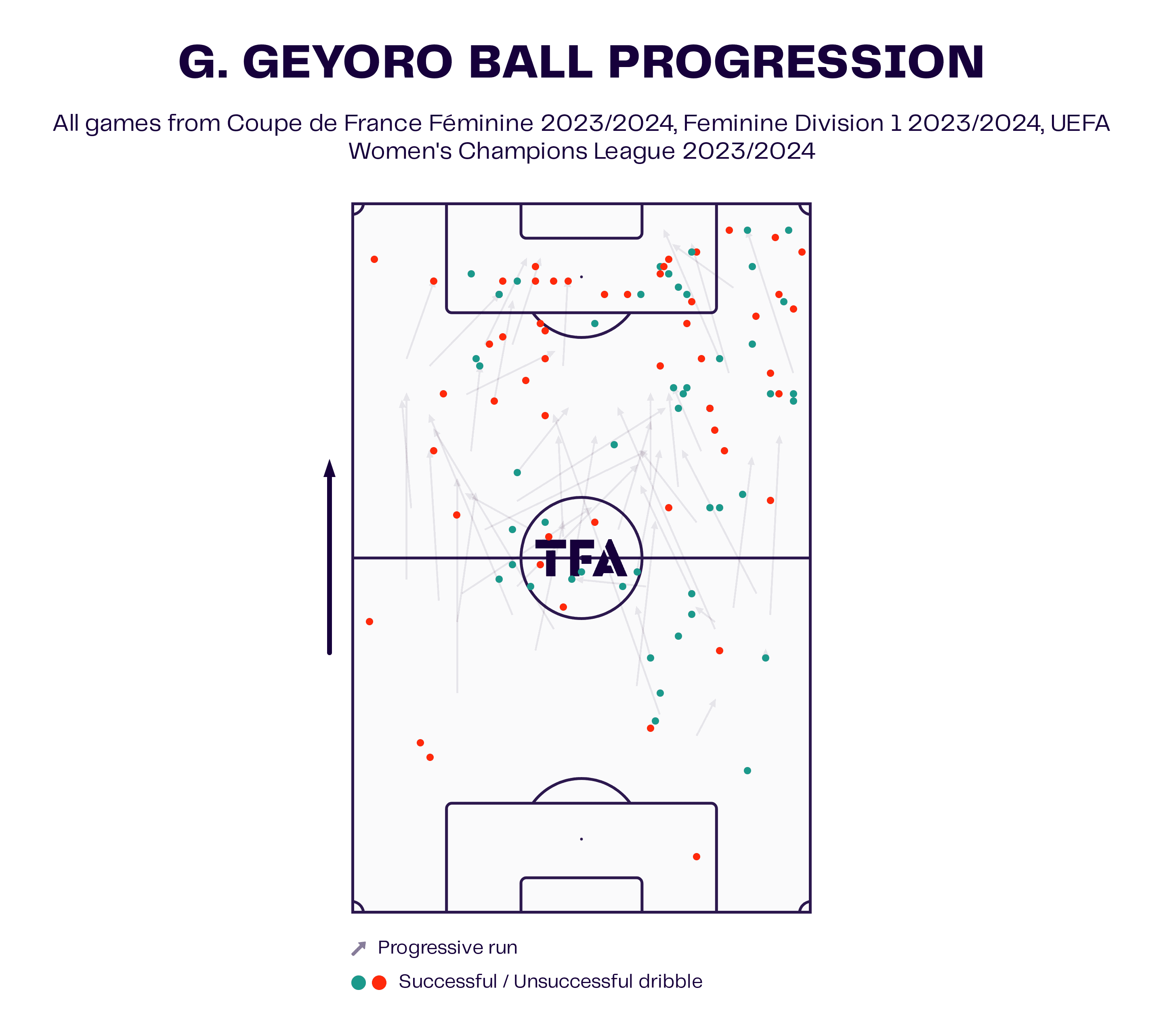
Right central midfielder Grace Geyoro is never shy to demand the ball and try to take opponents on with it at her feet — see her ball progression map from the 2023/24 campaign above. Expect her to prove vital to France’s attack and transitions to attack this summer.
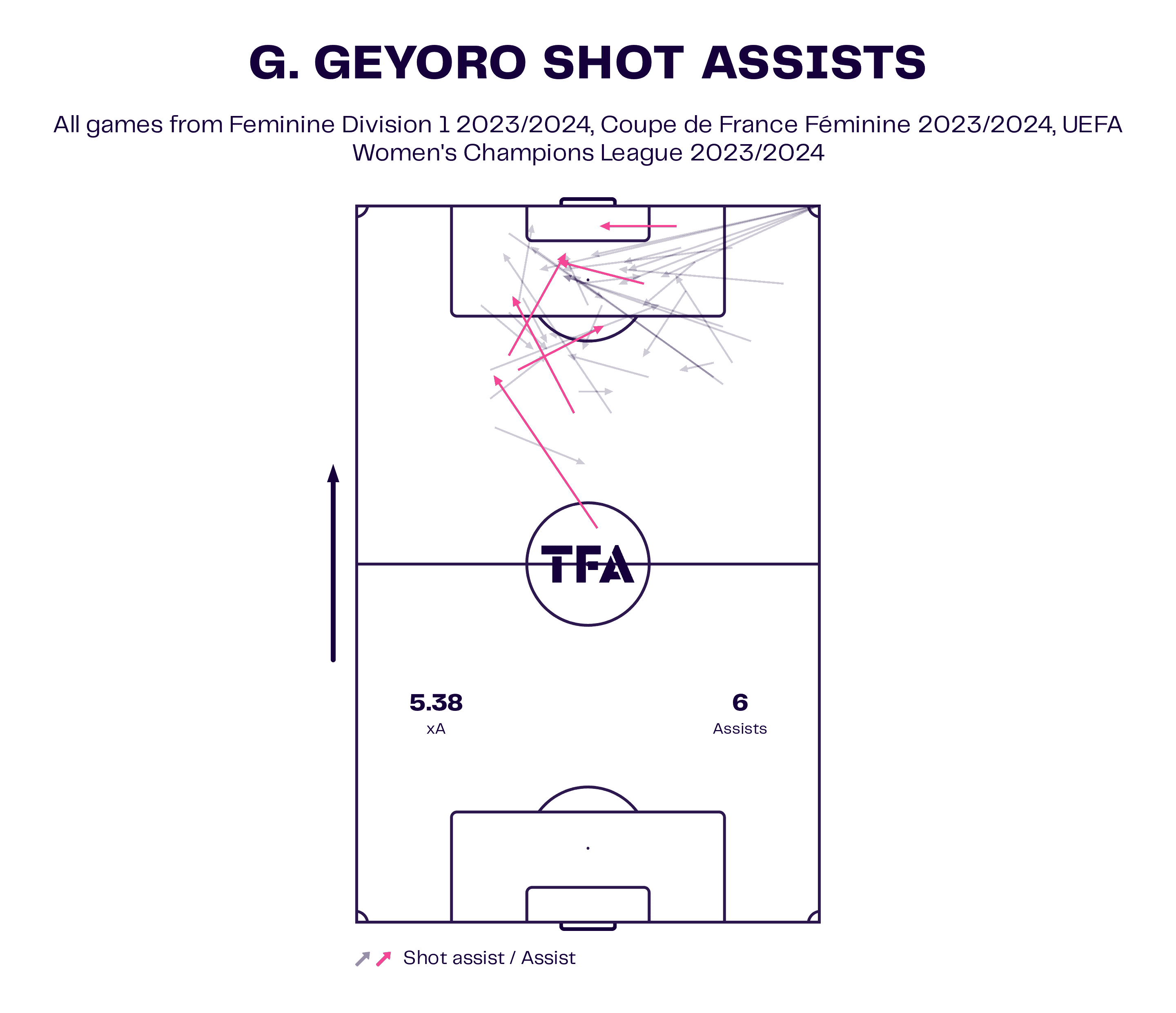
A capable playmaker from the middle of the park, Geyoro generated 5.38 expected assists and provided six actual assists for PSG in all competitions this past campaign.
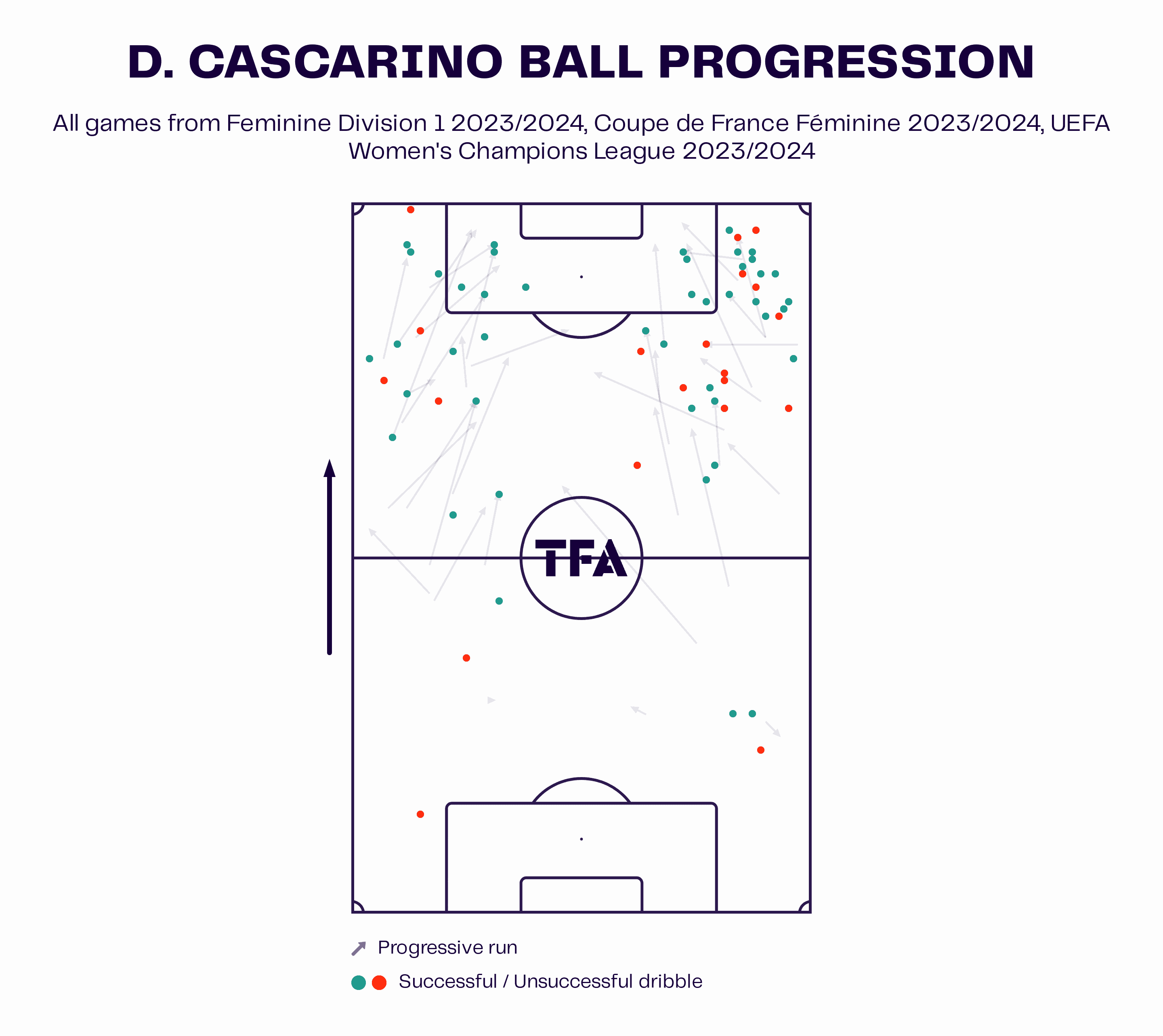
Similarly, Delphine Cascarino is likely to prove crucial to France’s chance creation. Her side will look to her to use her ball-carrying ability in the final third and to help them quickly put the opponent on the back foot in transition to attack.
Capable of hurting the opponent on either wing; see her ball progression map from the 2023/24 campaign in figure 12.
Defenders
In addition to our four starters — De Almeida (RB), Lakrar (RCB), Renard (LCB) and Karchaoui (LB), we’ve predicted Hervé Renard will bring Estelle Cascarino and Ève Périsset to this summer’s Olympics, completing the French defensive options.
We feel these two provide France with good cover across the backline; Périsset provides a different type of right-back option to De Almeida, far more of a creator similar to Karchaoui on the left, and Cascarino provides adequate cover at centre-back.
France also have Selma Bacha, who is very comfortable at left-back, in our predicted squad, so the defence should be well-equipped.
Midfielders
Backing up Toletti, Geyoro and Bacha, we’ve put veteran midfielder Amandine Henry and Kenza Dali in our predicted squad.
Henry is an excellent alternative in the deep-lying midfield position; she’ll likely get minutes over Toletti, either as a direct replacement for her or as a replacement for Bacha, with Toletti advancing to Bacha’s left central midfield position in our predicted starting XI.
Meanwhile, Dali is capable of operating in the left or right central midfield positions and potentially giving her side additional cover on the wings, making her another potentially valuable, versatile player.
Léa Le Garrec just about missed out on our predicted squad — she’s another fantastic player who has a great chance of being included as a central midfield option.
Forwards
We’ve put Eugénie Le Sommer into our predicted squad, though her inclusion is heavily dependent on her current fitness levels. Even if not 100% fit, we feel she may be a valuable squad member for Hervé Renard, given her immense experience and her goalscoring prowess. This could prove crucial for Les Bleues despite maybe not being able to offer as much of herself to the team as she’d like.
Along with Le Sommer, we’ve included 24-year-old Sandy Baltimore as a backup option to the starting trio of Diani, Katoto and Cascarino, with her and Le Sommer capable of providing ample competition for those starters.
Key Player
We’ve chosen Lyon’s Kadidiatou Diani as France’s key player, though plenty, including Katoto, Geyoro, and Renard, are likely to prove critical to Les Bleues at times during the tournament.
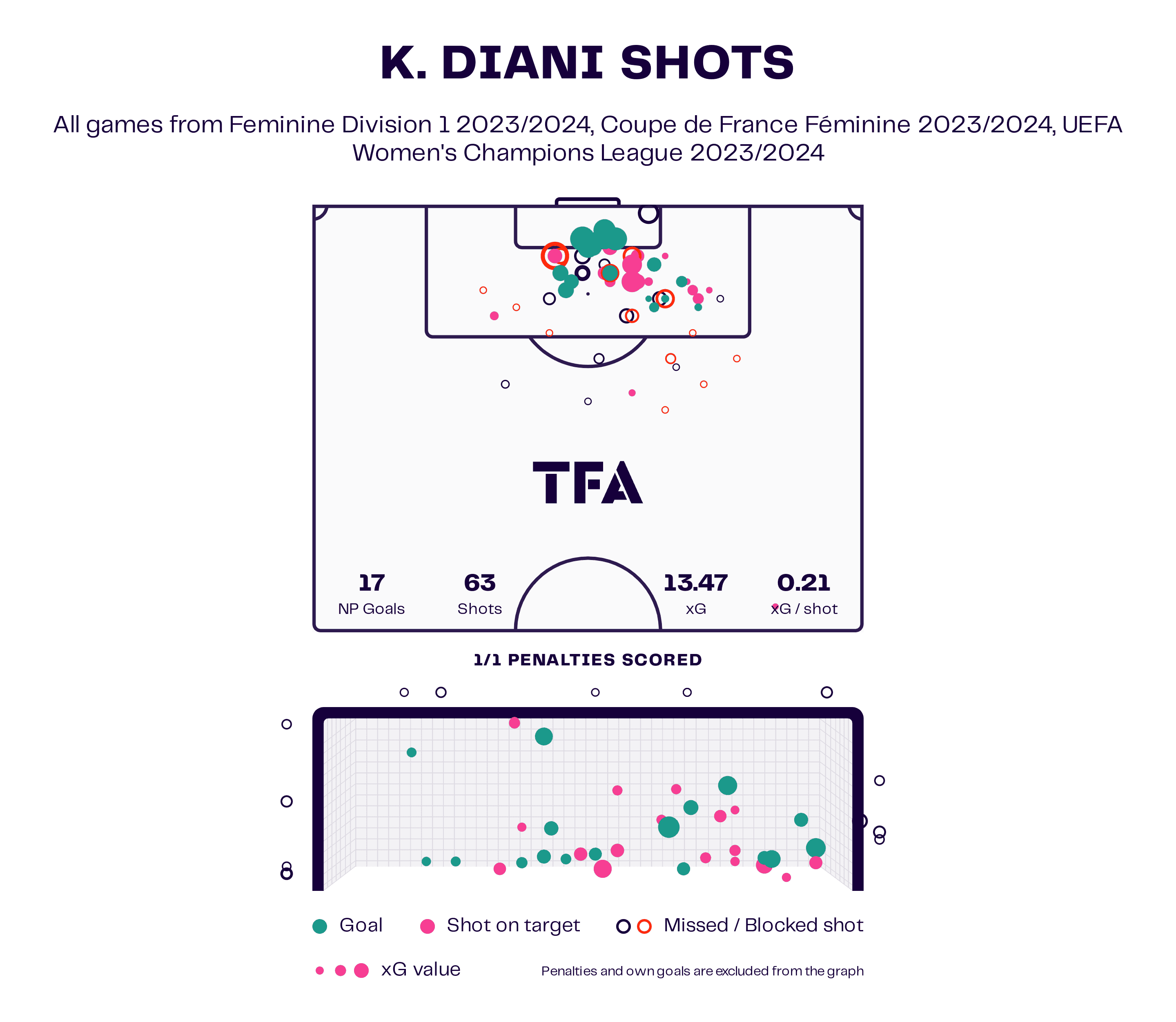
Diani is entering the Olympics from a stellar 2023/24 campaign in which she bagged 18 goals (17 non-penalty goals) in all competitions from 13.47 expected goals (xG).
The Lyon forward averaged 0.21 xG per shot—a very decent average that reflects her top-class positioning, shot selection, and movement, which allowed her to successfully occupy high-quality goalscoring areas and get onto the ball there with regularity.
As per her 2023/24 shot map in figure 13, the forward mainly shoots towards the ‘near’ post from her side of the pitch, with Diani typically operating on the right side of attack, as indicated by our expected lineup back in figure 1 and her heatmap from the 2023/24 campaign in figure 14 below.
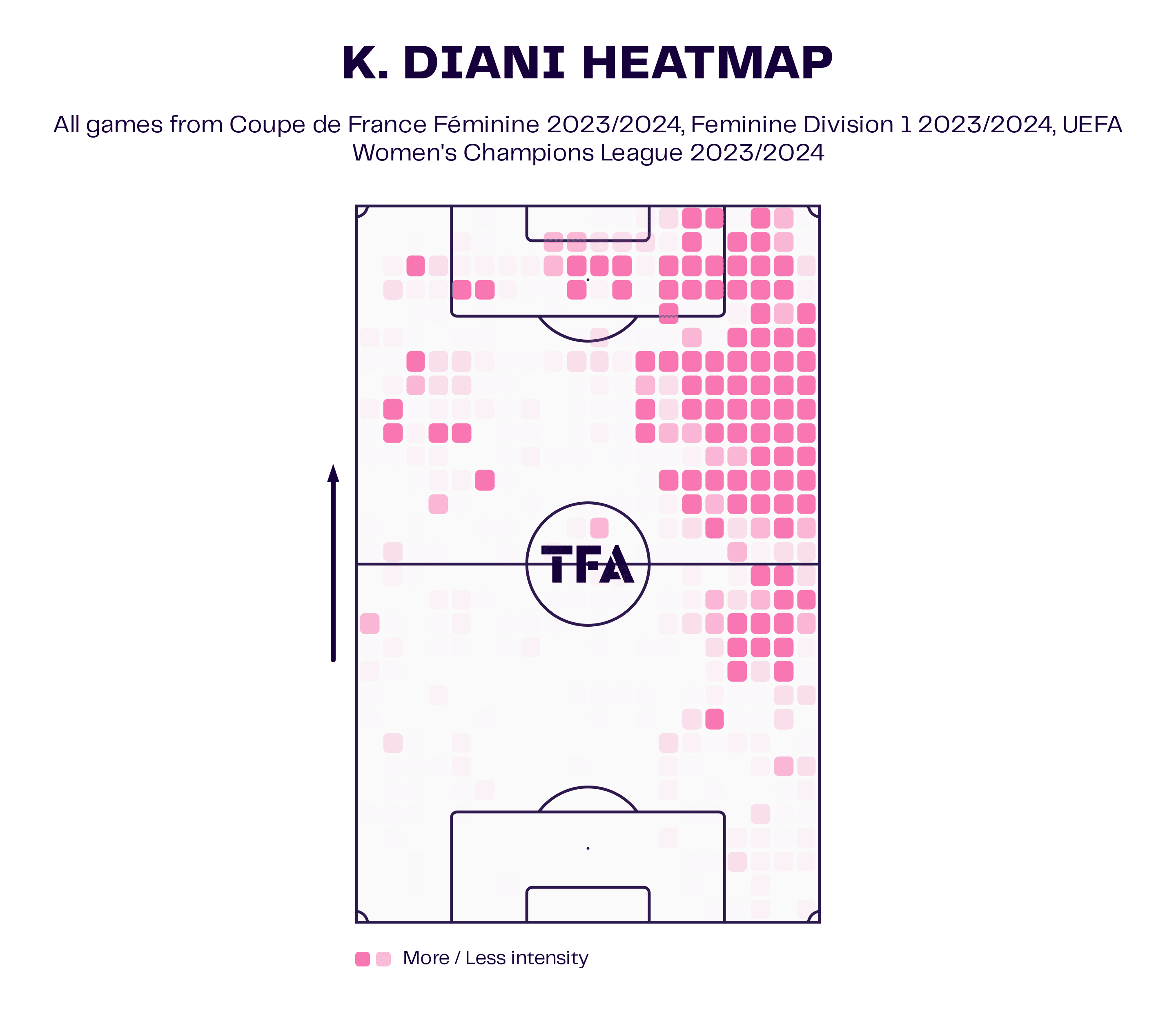
This heatmap is indicative of her role out on the wide right, where we’ll expect to see her spend a decent amount of time for France in the Olympics. However, she’s going to pop up in excellent goalscoring positions inside the box and showcase her positional and tactical intelligence via out-to-in runs, which will allow her to attack the box and generate the high-percentage chances we discussed above.
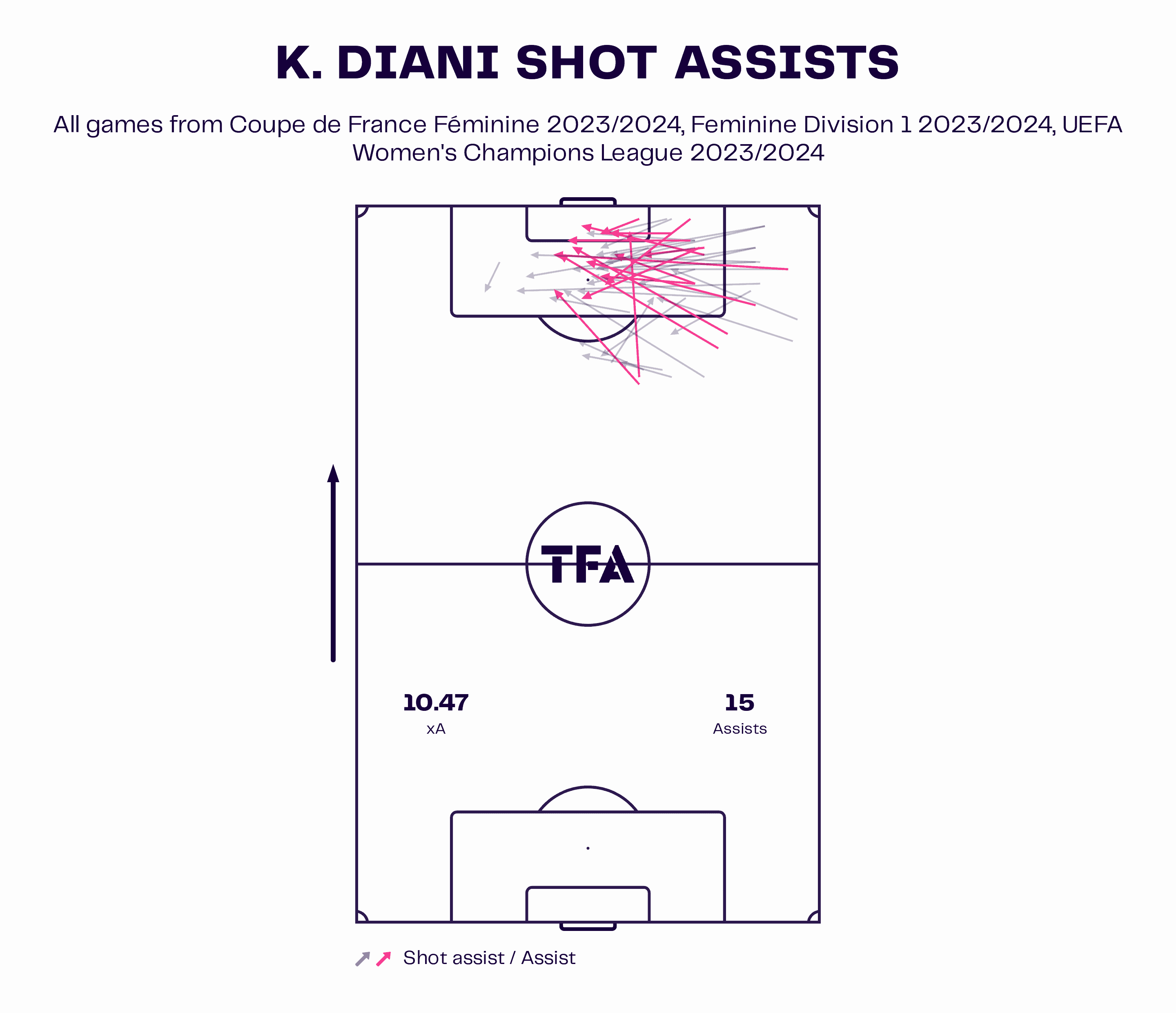
Not just a goalscorer, Diani will also bring creativity to the French forward line. This past season with Lyon, she generated 10.47 xA and contributed 15 assists— see the locations of her shot assists for 2023/24 in figure 15.
Tournament prediction
Simply based on quality, France should be aiming for no less than equalling their 2012 showing in the Olympics, finishing within the top-four.
With a home crowd to spur them on, as well as a core of in-form players entering the tournament off the back of a stellar 2023/24 with their respective clubs, a team primarily in its prime and a tournament specialist at the helm in Hervé Renard — all signs are pointing in the right direction for France who’ll probably be aiming to at least go all the way to the final but tough competition awaits in the form of the USA and Spain who’ll be well equipped to spoil the party and take gold for themselves.

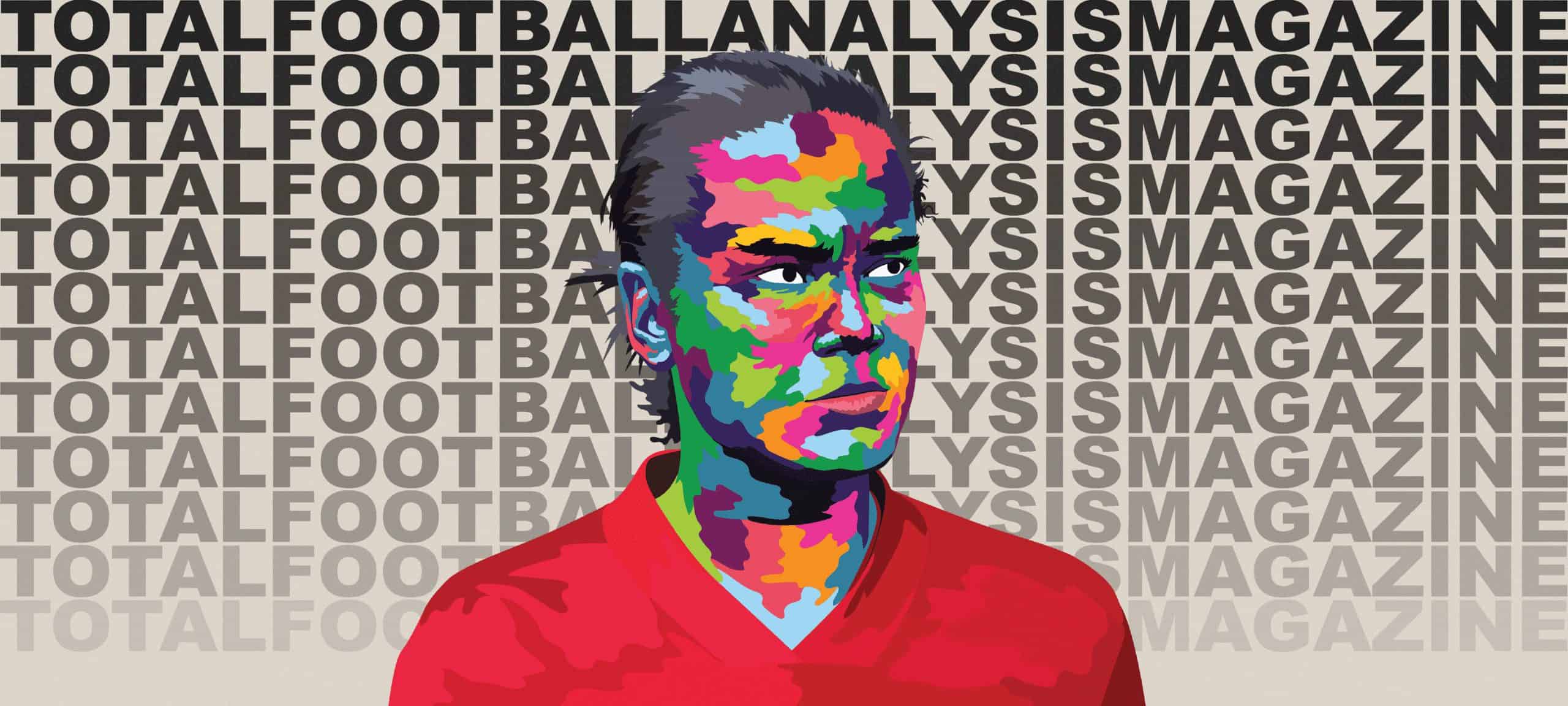


Comments